The influence of freeze-thaw cycles on the granulometric composition of Moscow morainic clay
Ze Zhang ,Vadim V.Pendin ,WenJie Feng ,ZhongQiong Zhang
1.State Key Laboratory of Frozen Soil Engineering,Cold and Arid Regions Environmental and Engineering Research Institute,Chinese Academy of Science,Lanzhou,Gansu 730000,China
2.Department of Engineering Geology,Russian State Geological Prospecting University,Moscow,Russian Federation
1 Introduction
In natural conditions,more than 100 freeze-thaw cycles occur on the ground surfaces of cold areas in the duration of one year,with temperatures alternately rising above and falling under 0 °C(Yershov,1982).Therefore,over a period of several years,the freeze-thaw cycles will inevitably influence the soil and rock of the ground surface.
Most current studies focus on the impact of the freeze-thaw cycle on the physical-mechanical properties of soil.Although the freeze and thaw cycle effect greatly influences the basic physical properties of soil,the results of such experiments cannot be compared to each other.Observations have shown that the freezing and thawing process alters the permeability and structure of fine-grained soils.In all cases,freezing and thawing cause a reduction in the void ratio and an increase in vertical permeability(Chamberlain and Gow,1979),while the soil plasticity index simultaneously increases(Chamberlainet al.,1990;Zimmie and Laplante,1990).In the case of morainic clay,all physical indicators(density,plasticity,porosity,etc.)tend to a constant after they decrease during the freeze-thaw cycle(Zhang and Pendin,2010).In the two kinds of soils(loam and light loam)frequently tested in freezing and thawing circulation experiments,the repeated freezing and thawing promote the dry density of soil tending to a constant.In other words,dependent on the soil type,the high-void ratio is reduced and the low-void ratio is increased(Yanget al.,2003).Although studies of the impact of the freeze-thaw cycle effect on the mechanical properties of soil relate to each other,they have different results.Some studies have found that freezing and thawing increases the strength of the soil(Wanget al.,1996),some have found the process reduces the strength of the soil(Broms and Yao,1964;Chuvilin and Yazynin,1988),and other studies have found the soil strength remains unchanged(Bondarenko and Sadovsky,1991;Christopher and Christopher,1998).
In sum,all results have indisputably proven that the freeze-thaw cycle leads to changes in the physical-mechanical properties of soil,but the explanations of why these changes occur are different.These varied conclusions result from the fact that changes occur different due to the grain sizes within the soil.Grain size is the most important factor in determining soil characteristics,such as soil structure,texture,composition,and the physical-mechanical properties of soil(Sergeev,1990).
Several scholars have analyzed changes in soil grain size under the impact of the freeze-thaw cycle,and their researches confirm that soil grains accumulate after the freeze-thaw process at a certain fraction,e.g.,0.01–0.05 mm(Minervin and Sergeev,1964),0.10–0.01 mm(Konischev,1977),or 0.10–0.05 mm(Zhang and Pendin,2010).These results could be explained by the division of coarse grains(quartzes,feldspar,etc.),and by the aggregation of clay and silt grains(Mazurov,1970;Morozovet al.,1973;Roman and Zhang,2010).However,we speculated that these different accumulations might cause the soil to have different properties,and as Konischevet al.(1974)pointed out,the aggregation and division processes accompany the freeze-thaw process.
Up until now,few studies have been completed on the rules regarding change in soil grain division and aggregation(i.e.,the changes of soil grain fraction).Thus,our present paper aims to explain the dynamic changes of the soil fraction and its variability.
2 Experimental design
Our soil specimens were composed of morainic clay(gQIIm)brought from the Moscow oblast and obtained from 5 m to 7 m underground,because at this depth the influence of the atmosphere could not be a factor.Two series of morainic clayey specimens were taken as study objects,(I)original and(II)remolded.Series I was made from monoliths,and Series II was made from disturbed soil,which we dried,pulverized,passed through a 2-mm sieve,and wet with distilled water.All of the samples from both the original and remolded series were prepared in the laboratory with cutting ring,of which the diameter is 56.6 mm and height is 20 mm.The specimens were placed in an insulated mold for parallel-plane freeze-thawing(Figure 1).
The tests on both Series I and Series II included 40 freeze-thaw cycles and a temperature range for each freeze-thaw cycle based on local temperature changes.The specimens were frozen for 16 hours in a refrigeration chamber at-7 °C,and then thawed and maintained for 8 hours at 20 °C.Each series was subjected to a different number of freeze-thaw cycles(3,6,20,and 40 cycles).Table 1 shows the physical properties and grain-size distribution of the original and remolded soil specimens.
3 Results
Figure 2 reports the outcome of the granulometric test.The chart shows that the semi-logarithmic curve of two series of morainic clayey specimens changed with the increasing number of times the specimens experienced freeze-thaw cycles.Every size fraction in all of the specimens in both series changed,but the variable quantity differed.
Figure 3 shows our results with respect to the changes of average granule size(d50).We found that the average granule size of both series of specimens increased as the number of freeze-thaw cycles they experienced rose.However,thed50of the original specimen(Series I)decreased between the third and the sixth freeze-thaw cycles.A possible explanation for the decrease ofd50in the original(I)specimen is that it had a lower percentage of coarse sand than the remolded(II)specimen,which had passed through a 2-mm sieve and retained a higher percentage of coarse sand content.Therefore,we can conclude that the division of coarse sand mainly took place between the third and the sixth freeze-thaw cycles.
To determine the real effects of the freeze-thaw cycles on granulometric characterization,we recorded changes in fractions in the morainic clay during the different number of freeze-thaw cycles,as shown in Figure 4.From these records,we can see that,for both series specimens,the content of fraction for 0.1–0.05 mm increased after 40 freeze-thaw cycles(i.e.,0.1–0.05 mm was the accumulative fraction).However,our recent study of the changes of granulometric fractions did not reveal any rules regarding the increase of the fraction at 0.1–0.05 mm,meriting a call for further investigation.
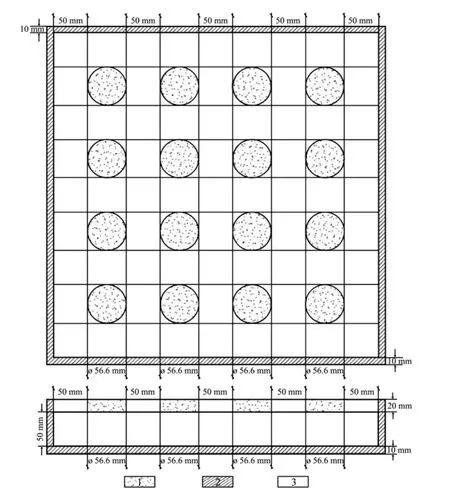
Figure 1 An insulated mold for a parallel-plane freeze-thaw test.(1)soil specimens;(2),(3)thermal insulation material
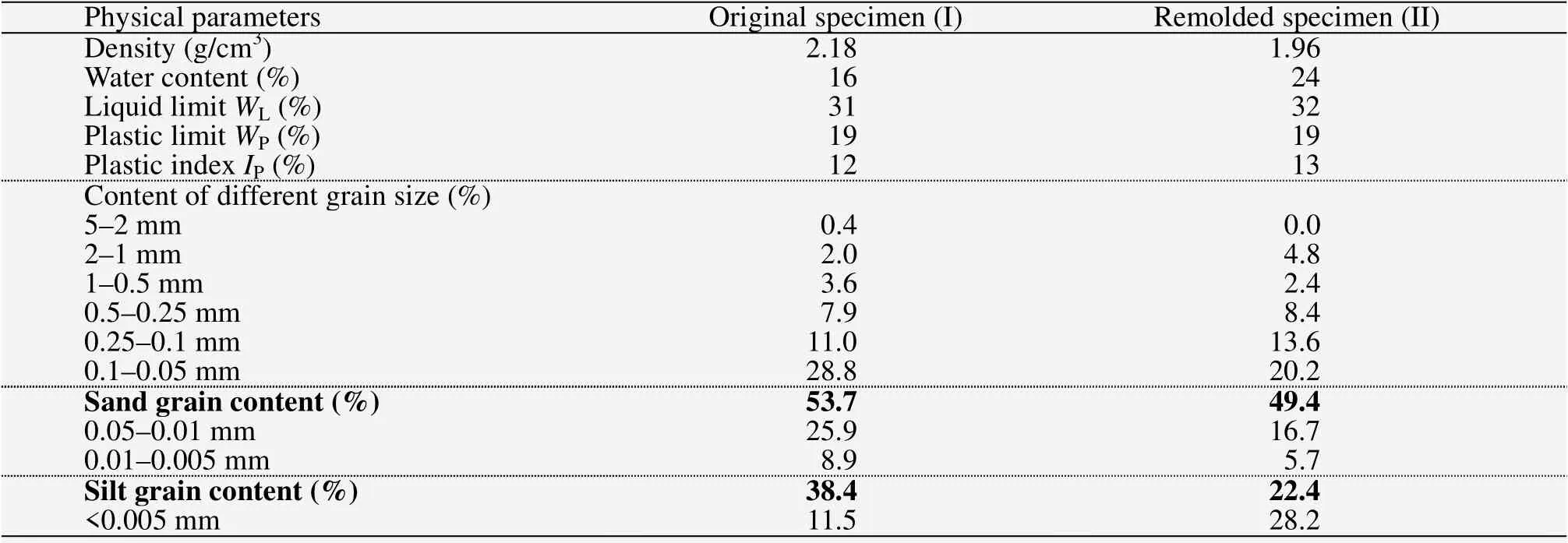
Table 1 Physical properties and granularity composition of soils tested

Figure 2 The grain size distribution semi-logarithmic curve of Moscow morainic clay with different numbers of freeze-thaw cycles.(a)original soil specimen;(b)remolded soil specimen
The two main aspects of both of the series specimens that are key to understanding the process of dynamic changes are 1)the changing characteristics of sand,silt,and clay grains,and 2)the mass change over freeze-thaw times for each fraction.
Figure 5 shows the process of the changing characteristics of sand,slit,and clay grains.According to the changes in both series specimens,we can confirm the division and aggregation of soil grains during the freeze-thaw process.In the original specimens,the change of the sand was inversely related to the changes of the clay;when the amount of sand was increased,the amount of clay was decreased,and when the amount of sand was decreased,the amount of clay was increased(Figure 5a).In contrast,in the remolded specimens,the change of sand was inversely related to the change of silt(Figure 5b).From these results,we can conclude that the division and aggregation of soil grains were conjugated,leading to the accumulation of a certain fraction during the process of freeze-thaw cycles.

Figure 3 Changes in average granule size(d50)with the increasing number of freeze-thaw cycles
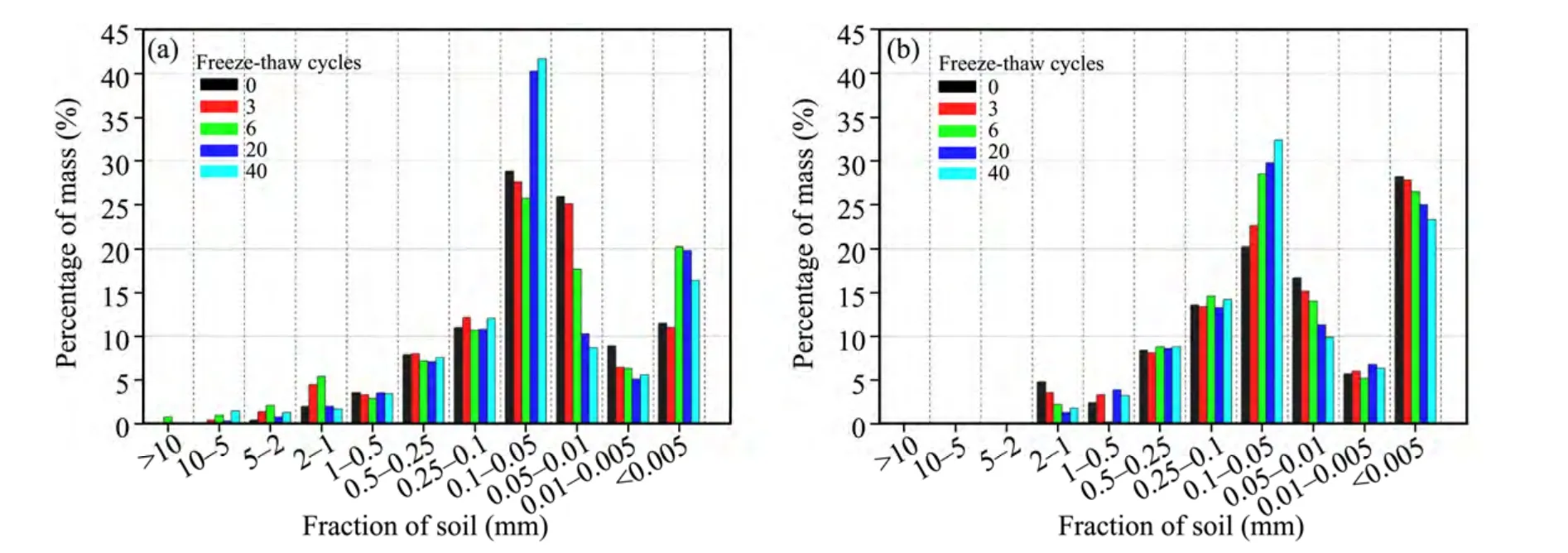
Figure 4 Changes in granulometric composition of original(a)and remolded(b)soil specimens with different numbers of freeze-thaw cycles
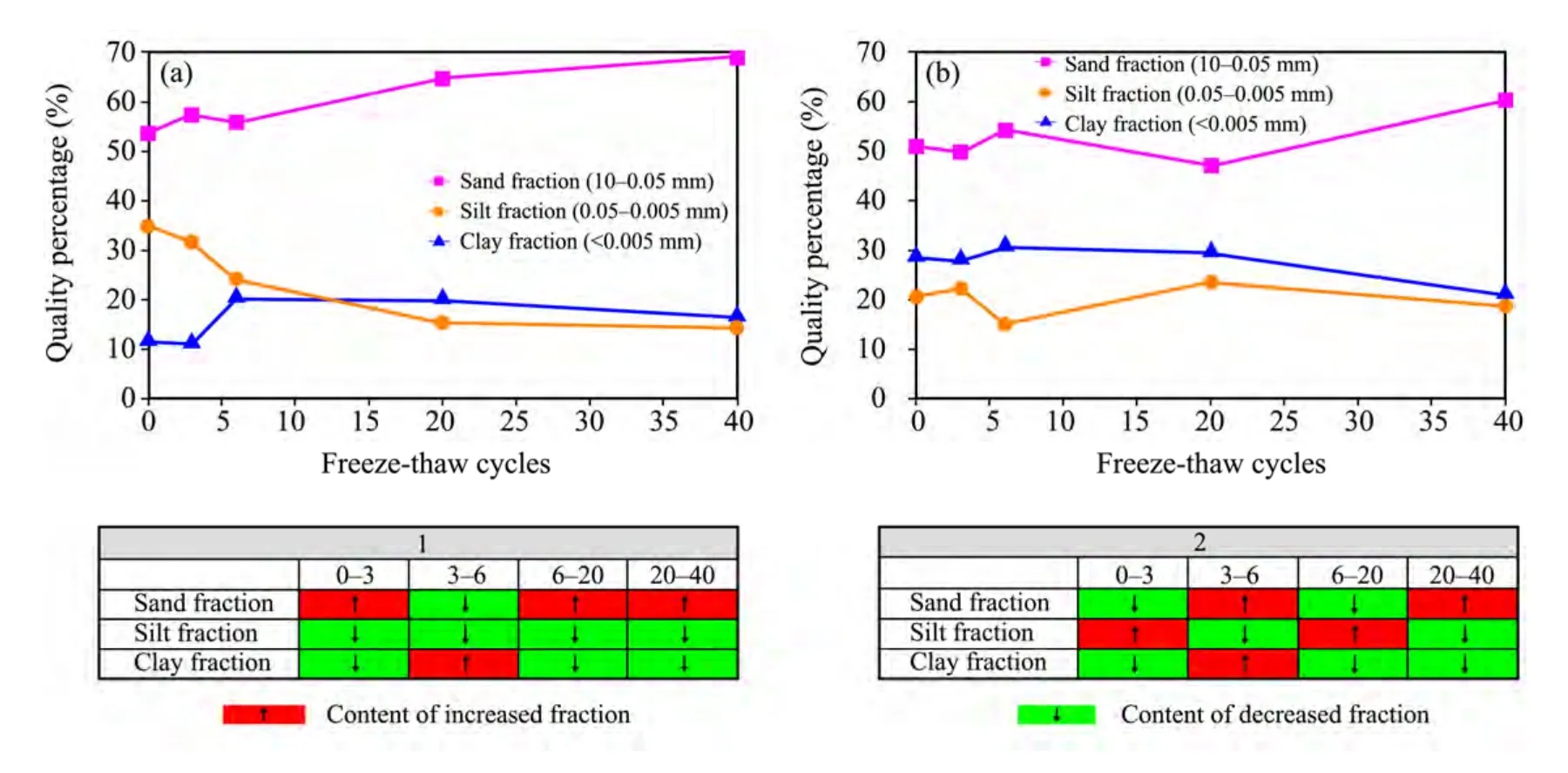
Figure 5 Changes in sand,silt,and clay fraction of original(a)and remolded(b)soil specimens with the increasing number of freeze-thaw cycles
To further determine dynamic changes of the soil fraction,we used the parameter of mass change for each fraction,which can be expressed as:

whereAis the content of fraction before the freeze-thaw test;Bis the content of fraction after the freeze-thaw test;iis the different fraction;andnis the number of freeze-thaw cycles.Figure 6 summarizes our results with respect to the process of the increase and decrease of fractions under the freeze-thaw effect.From this chart,we can observe that after 40 freeze-thaw cycles the original specimen(I)had positive changes in fractions at 0.1–0.05 mm and <0.005 mm,and negative changes in fractions at 0.01–0.005 mm and 0.05–0.01 mm,but the other changes were not obvious(Figure 6a).The remolded specimen(II)only had positive changes in fractions at 0.1–0.05 mm,and negative changes in fractions at <0.005 mm,0.05–0.01 mm,and 2–1 mm(Figure 6b).

Figure 6 Dynamic changes in mass change(ΔM)with the increasing number of freeze-thaw cycles
4 Discussion
4.1 The changing granulometric characteristics during the freeze-thaw process
Based on the results in Figure 6,we can speculate that granulometric compositions tended to be evenly distributed after 40 freeze-thaw processes.The change mainly stemmed from the fact that the division of coarse grains and the aggregation of fine grains were synchronized during the freeze-thaw process(Figure 5),i.e.,a bi-directional change of soil grains.With regard to the changes of sand,silt,and clay grains,we found that the change of sand grains and of clay grains in the original specimen were conjugated(Figure 5a),but that in the remolded specimen,the change of sand grains was conjugated with the change of silt grains(Figure 5b).Different mass,or potential energy difference,caused these variations in changes.In other words,the processes of division and aggregation were related to the process of counteraction in regard to potential energy difference,meaning the even distribution of soil grain size indicated a state of equilibrium or balance.
In both specimens,according to the increasing and decreasing extent of their fractions,it is possible that a fraction of 0.01–0.005 mm could change into a fraction of <0.005 mm;likewise,a fraction of 0.05–0.01 mm could change into a fraction of 0.01–0.005 mm.Concurrently,fractions of <0.005 mm,0.05–0.01 mm,and 2–1 mm could change into the fraction of 0.1–0.05 mm(Figure 6).
We can summarize these findings with Rehbinder's thoughts(1966)on creation through destruction,"…the essence of this process is to increase the strength of the solid state by destroying all its defects and subsequently fusing the formed solid…".
4.2 Analysis of intensity of grain fineness during the freeze-thaw process
The results of our experiment indicate that the granulometric compositions tended to be evenly distributed after 40 freeze-thaw processes.In order to demonstrate the intensity of granulometric changes,we used the coefficient of the intensity variation of grain fineness(Kvar)(Yershov,1995),expressed as:

in whichNis the number of freeze-thaw cycles;Ais the content of fraction before the freeze-thaw test;Bis the content of fraction after the freeze-thaw test;andiis the differing fraction.We obtained the changes inKvarafter each number of freeze-thaw cycles in two serial specimens,as shown in Figure 7.From these results,we can observe that in both serial specimens,theKvarincreased from the beginning of the freeze-thaw process to the sixth cycle,and decreased from the 6th cycle to the 40th cycle.At the 6th cycle,theKvarwas at its maximum.In regards to the classification of the intensity of the variation of grain fineness,theKvarof both serial specimens belonged to the medium intensity of variation from the beginning of the freeze-thaw process to the 20th cycle,and at the 40th cycle,theKvardecreased to the lowest intensity of variation(Figure 7).
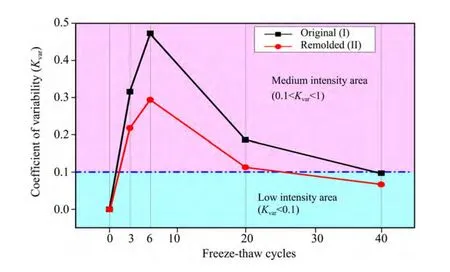
Figure 7 Changes of coefficient of intensity variation of grain fineness(Kvar)with the increasing number of freeze-thaw cycles
5 Conclusions
We subjected two series specimens,(I)original and(II)remolded,of Moscow morainic clay(gQIIm)to freeze-thaw conditions with different frequencies of freeze-thaw cycles(3,6,20,and 40 cycles).Before and after the freeze-thaw process,we analyzed both soil series through granulometric tests and made the following conclusions:
Under the effect of the freeze-thaw condition,the division of coarse grains and the aggregation of fine grains were synchronized(i.e.,a bi-directional change of soil grains);and in both series specimens,the content of fraction for 0.1–0.05 mm increased after 40 freeze-thaw cycles(i.e.,0.1–0.05 mm was the accumulative fraction).
In the original specimen,the changes in the sand grains and in the clay grains were conjugated,and in the remolded specimen,the change in the sand grains was conjugated with the change in the silt grains,because the processes of division and aggregation were related to the process of counteraction in regards to potential energy difference.The even distribution of soil grain size indicated equilibrium or balance.
Changes in the granulometric compositions were most active during the 6th cycle,meaning theKvarwas at its maximum value during the 6th cycle.
This work was supported in part by the National Natural Science Foundation of China(No.41301070),the West Light Program for Talent Cultivation of Chinese Academy of Sciences,and the project sponsored by the Scientific Research Foundation for the Returned Overseas Chinese Scholars,State Education Ministry,which granted to Dr.Ze Zhang.
Bondarenko GI,Sadovsky AV,1991.Water content effect of the thawing clay soils on shear strength.Proceedings of the 7th International Symposium on Ground Freezing,Rotterdam,Netherlands,pp.123–127.
Broms BB,Yao LYC,1964.Shear strength of a soil after freezing and thawing.Journal of the Soil Mechanics and Foundations Division,ASCE,90(4):1–25.
Chamberlain EJ,Gow AJ,1979.Effect of freezing and thawing on the permeability and structure of soils.Engineering Geology,13(1–4):73–92.DOI:10.1016/0013-7952(79)90022-X.
Chamberlain EJ,Iskander I,Hunsiker SE,1990.Effect of freeze-thaw cycles on the permeability and macrostructure of soils.Proceedings of International Symposium on Frozen Soil Impacts on Agricultural,Range and Forest Lands.Spokane,Washington.U.S.Army Cold Regions Research and Engineering Laboratory,Special Report 9021,pp.145–155.
Christopher S,Christopher G,1998.Freeze-thaw effects on Boston Blue clay.Journal of Engineering and Applied Science,Soil Improvement for Big Digs,81:161–176.
Chuvilin EM,Yazynin OM,1988.Frozen soil macro-and microstructure formation.Proceedings of the 5th International Conference on Permafrost,Trondheim,Norway,pp.320–323.
Konischev VN,1977.Some general regularities of the transformation of dispersed rock composition by cryogenic processes.Problems of Cryolithology(Moscow),6:114–129.(in Russian)
Konischev VN,Rogov VV,Shurina GN,1974.The influence of cryogenic processes on clay minerals.Bulletin of Moscow State University(Series Geography),1:1–8.(in Russian)
Mazurov GP,1970.The formation of the composition and properties of soils in the subarctic zone under the influence of cryogenic processes.Problems of Engineering Geology.Reports of Soviet Scientists to the International Congress of the International Association of Engineering Geologists,Moscow,pp.118–125.
Minervin AV,Sergeev EM,1964.New data on the problem of loess.Publishing Academy of Sciences USSR(Geology Series),9:53–64.(in Russian)
Morozov S,Vassiliev V,Datsko Y,1973.Changes in the composition and properties of loose rocks under the influence of long-term cross freezing and thawing.In:Problems of Engineering Geology and Soil Science.Moscow State University,Russia.
Rehbinder P,1966.Physical-chemical mechanics of disperse structures.Moscow,Russia:Publishing House of Science,pp.400.
Roman LT,Zhang Z,2010.Effect of freezing-thawing on the physico-mechanical properties of a morianic clayey loam.Soil Mechanics and Foundation Engineering,47(3):96–101.DOI:10.1007/s11204-010-9095-3.
Sergeev EM,1990.Soil Science(Translation from Russian to Chinese).Beijing,China:Geological Publishing House.
Wang JC,Xu XZ,Wang YJ,1996.Thermal sieve effect and convectional migration of soil particles during unidirectional freezing.Journal of Glaciolgy and Geocryology,18(3):252–255.
Yang CS,He P,Cheng GD,et al.,2003.Testing study on influence of freezing and thawing on dry density and water content of soil.Chinese Journal of Rock Mechanics and Engineering,22(S2):2695–2699.
Yershov ED,1982.Cryolithogenesis.Nedra,Moscow,Russia,pp.211.(in Russian)
Yershov ED,1995.Fundamentals of Geocryology,Part 1:Physical-Chemical Basis of Geocryology.Moscow State University,Russia,pp.368.(in Russian)
Zhang Z,Pendin VV,2010.Conversion of moraine loam with repeated freezing and thawing.Geology and Exploration,2:58–63.(in Russian)
Zimmie TF,Laplante C,1990.The effect of freeze-thaw cycles on the permeability of a fine grained soil.Proceedings of 22nd Mid-Atlantic Industrial Waste Conference.Drexel University,Philadelphia,USA,pp.580–593.
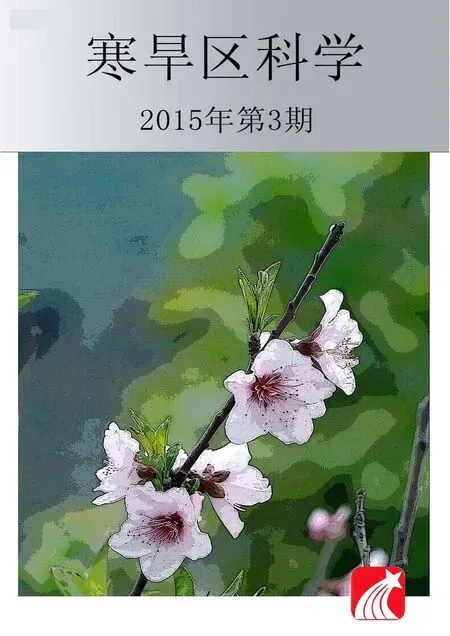 Sciences in Cold and Arid Regions2015年3期
Sciences in Cold and Arid Regions2015年3期
- Sciences in Cold and Arid Regions的其它文章
- Aesthetic evaluation of yardang landforms landscape:the Dunhuang Yardang National Geo-park example
- Comparative studies on leaf epidermal micromorphology and mesophyll structure of Elaeagnus angustifoliaL.in two different regions of desert habitat
- Biomass and water partitioning in two age-related Caragana korshinskii plantations in desert steppe,northern China
- Characterizing stand structure in a spruce forests:effects of sampling protocols
- Characterizing changes in ecosystem service values in China's eastern Loess Plateau
- The characteristics of oasis urban expansion and drive mechanism analysis:a case study on Ganzhou District in Hexi Corridor,China
